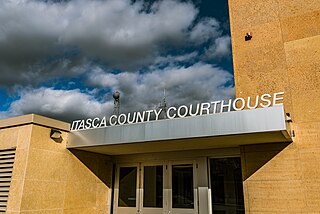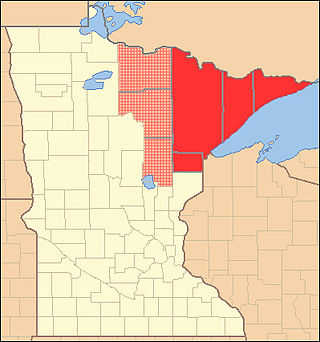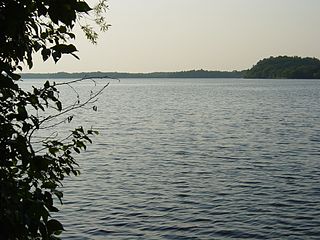
The Great River Road is a collection of state and local roads that follow the course of the Mississippi River through ten states of the United States. They are Minnesota, Wisconsin, Iowa, Illinois, Missouri, Kentucky, Tennessee, Arkansas, Mississippi and Louisiana. It formerly extended north into Canada, serving the provinces of Ontario and Manitoba. The road is designated as both a National Scenic Byway and an All-American Road in several states along the route.

Itasca County is a county located in the Iron Range region of the U.S. state of Minnesota. As of the 2020 census, the population was 45,014. Its county seat is Grand Rapids. The county is named after Lake Itasca, which is in turn a shortened version of the Latin words veritas caput, meaning 'truth' and 'head', a reference to the source of the Mississippi River. Portions of the Bois Forte and Leech Lake Indian reservations are in the county.

Aitkin County is a county in the U.S. state of Minnesota. As of the 2020 census, the population was 15,697. Its county seat is Aitkin. Part of the Mille Lacs Indian Reservation is in the county. The county was created in 1857 and organized in 1871.

The Public Land Survey System (PLSS) is the surveying method developed and used in the United States to plat, or divide, real property for sale and settling. Also known as the Rectangular Survey System, it was created by the Land Ordinance of 1785 to survey land ceded to the United States by the Treaty of Paris in 1783, following the end of the American Revolution. Beginning with the Seven Ranges in present-day Ohio, the PLSS has been used as the primary survey method in the United States. Following the passage of the Northwest Ordinance in 1787, the Surveyor General of the Northwest Territory platted lands in the Northwest Territory. The Surveyor General was later merged with the United States General Land Office, which later became a part of the U.S. Bureau of Land Management (BLM). Today, the BLM controls the survey, sale, and settling of lands acquired by the United States.
The Swan River is a tributary of the Mississippi River, approximately 60 mi (97 km) long, in northeastern Minnesota in the United States.

The Willamette Stone was a small stone obelisk originally installed by the Department of Interior in 1885 in the western hills of Portland, Oregon, in the United States to mark the intersection and origin of the Willamette meridian and Willamette baseline. It replaced a cedar stake placed by the Surveyor General of the Oregon Territory in 1851; this stake defined the grid system of sections and townships from which all real property in the states of Oregon and Washington has been measured following the Donation Land Claim Act of 1850. The Willamette meridian runs north–south, and the Willamette baseline runs east–west through the marker. The easternmost northeast corner of Washington County is sited on the marker.

The Arrowhead Region is located in the northeastern part of the U.S. state of Minnesota, so called because of its pointed shape. The predominantly rural region encompasses 10,635.26 square miles (27,545.2 km2) of land area and includes Carlton, Cook, Lake and Saint Louis counties. Its population at the 2000 census was 248,425 residents. The region is loosely defined, and Aitkin, Itasca, and Koochiching counties are sometimes considered as part of the region, increasing the land area to 18,221.97 square miles (47,194.7 km2) and the population to 322,073 residents. Primary industries in the region include tourism and iron mining.
La Pointe County was created on February 19, 1845, by the Territory of Wisconsin from the northern portion of the existing territorial St. Croix County, encompassing the remaining portions of the Northwest Territory in Wisconsin Territory north of the line drawn from the confluence of the Ripple River with the Mississippi River to the western edge of Lac Courte Oreilles, to the eastern edge of Lac Courte Oreilles, and to the western branch of the Montreal River. The county was named for the community of La Pointe, Wisconsin on Madeline Island, which was its county seat from 1858 until 1866.
A principal meridian is a meridian used for survey control in a large region.

Minnesota State Highway 200 (MN 200) is a 201.203-mile-long (323.805 km) highway in northwest and northeast Minnesota, which runs from North Dakota Highway 200 at the North Dakota state line near Halstad, and continues east to its eastern terminus at its intersection with U.S. Highway 2 in Northeast Aitkin County, 9-miles west of Floodwood.

Dunleith Township is one of 23 townships in Jo Daviess County, Illinois, United States. As of the 2010 census, its population was 3,820 and it contained 1,713 housing units. It was formed from Menominee Township on March 2, 1865.
Joseph Cromwell Brown was an American surveyor known for establishing the Fifth Principal Meridian's baseline that governs the surveys of all or part of present-day Arkansas, Iowa, Minnesota, Missouri, and South Dakota. The Fifth Principal Meridian was established in 1815 to survey the territory of the Louisiana Purchase, an area of 830,000 square miles (2,100,000 km2).

Big Sandy Lake is a lake in Aitkin County, Minnesota, approximately nine miles north of McGregor. The lake is considered fertile walleye ground with several habitat types, including the open main basin, the deep, cold eastern basin, and a shallow, more isolated south basin. Shallow bays containing dense beds of wild rice are found on south, west, and northwest sides of the lake.
The Choctaw meridian is a meridian that governs the surveys in most of central Mississippi, USA. It begins on the Choctaw baseline, latitude 31° 54' 40" north, longitude 90° 14' 45" west from Greenwich and runs north to the south boundary of the Chickasaw cession, at latitude 34° 19' 40" north. The surveys of Mississippi by the United States General Land Office begun in 1831 "used the 'Old Choctaw Line' as the 'base meridian' of their efforts to transform the landscape from a landscape of imperial violence to a field of national development."

The Fifth Principal Meridian, also known as the "5th Principal Meridian" and "PM 05", is a principal meridian survey line used in the United States for land claims in the Public Land Survey System (PLSS). It was first surveyed in 1815. The meridian, a north-south line, starts from the old mouth of the Arkansas River and runs north. Another survey line related to it is the base line running west from the old mouth of the St. Francis River. These survey lines govern all land surveys in four states and a large portion of the land surveys for two more. Monuments have been erected where the two lines meet at 34°38′44″N91°3′42″W, and the surveyors' skill has been commemorated at the Louisiana Purchase State Park in eastern Arkansas. The Fifth Principal Meridian is nearly coincident with 91° 3′ 42″ longitude west from the Greenwich meridian.

The Saint Stephens meridian, in longitude 88° 02′ west from Greenwich, begins at the initial point, on the base line, in latitude 31° north, passes through Saint Stephens, Alabama, extends south to Mobile Bay and north to latitude 33° 06′ 20″, and governs the surveys in the southern district of Alabama, and in Pearl River district lying east of the river and south of the Choctaw Baseline, in latitude 31° 52′ 40″ north, in the state of Mississippi.

Saint Helena meridian begins at the initial point of the Washington meridian, in latitude 31° north, and longitude 91° 09′ 15″ west of Greenwich, passing one mile east of Baton Rouge, extends south to the Mississippi River, and governs the surveys in the Greensburg and southeastern districts of Louisiana, east of the Mississippi River.

The Louisiana meridian, in longitude 92° 24′ 15″ west of Greenwich, extends from the Gulf of Mexico to the north boundary of Louisiana, and with the baseline through the initial point conforming to the parallel of 31° north latitude, governs all the surveys in the state west of the Mississippi River.
The Navajo meridian, established in 1869, is one of the two principal meridians for Arizona, the other being the Gila and Salt River meridian. Its initial point was stated as latitude 35° 45' north, longitude 108° 32' 45" west from Greenwich, but has been revised as 35°44′56″N108°31′59″W The Navajo meridian and baseline were used to set townships and ranges in a special survey for the original Navajo Reservation, and was set at the eastern boundary of that reservation. The Arizona lands surveyed using the Navajo meridian and baseline were ranges six west to ten west and townships one north to fourteen north, and included Canyon de Chelly National Monument.
4th meridian may refer to:











